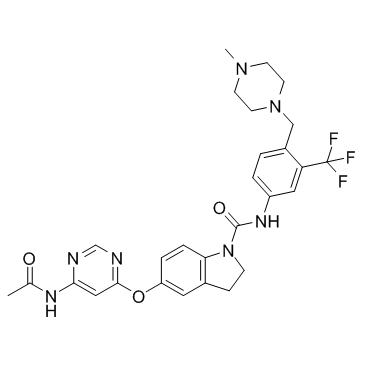882405-89-2
| Name | BBT594 |
|---|---|
| Synonyms |
1H-Indole-1-carboximidic acid, 2,3-dihydro-5-[[6-[[(1E)-1-hydroxyethylidene]amino]-4-pyrimidinyl]oxy]-N-[4-[(4-methyl-1-piperazinyl)methyl]-3-(trifluoromethyl)phenyl]-
NVP-BBT594 5-({6-[(E)-(1-Hydroxyethylidene)amino]-4-pyrimidinyl}oxy)-N-{4-[(4-methyl-1-piperazinyl)methyl]-3-(trifluoromethyl)phenyl}-1-indolinecarboximidic acid |
| Description | BBT594 is a potent receptor tyrosine kinase RET inhibitor, used for cancer treatment. |
|---|---|
| Related Catalog | |
| In Vitro | NVP-BBT594 blocks the GDNF-mediated enhancement of MCF7-LTED cell viability in 2D culture and 3D colony formation. The addition of 10 pM E2, to mimic the E2 level in post-menopausal patients that have relapsed on AI treatment and ceased AI therapy, increases 3D colony formation of both MCF7 and MCF7-LTED cells, and this effect is efficiently reverted by NVP-BBT594. Parental T47D cells cultured in presence of low level E2, GFRα1/GDNF stimulation results in increased 3D colony formation, which is significantly reverted by NVP-BBT594. NVP-BBT594 targets GDNF-RET signaling and sensitizes MCF7-2A cells to letrozole treatment. NVP-BBT594 impairs GDNF-mediated RET downstream signaling and significantly enhances the antiproliferative effects of letrozole[1]. NVP-BBT594 shows the highest suppression of GDNF-induced RET signaling, as assessed by RET, ERK1/2, AKT and ER phosphorylation. NVP-AST487 and NVP-BBT594 have comparable RET inhibitory activity in wild-type MCF7 cells[2]. |
| References |
| Density | 1.4±0.1 g/cm3 |
|---|---|
| Boiling Point | 723.9±70.0 °C at 760 mmHg |
| Molecular Formula | C28H30F3N7O3 |
| Molecular Weight | 569.578 |
| Flash Point | 391.6±35.7 °C |
| Exact Mass | 569.236206 |
| LogP | 3.28 |
| Vapour Pressure | 0.0±2.5 mmHg at 25°C |
| Index of Refraction | 1.640 |
| Storage condition | 2-8℃ |
